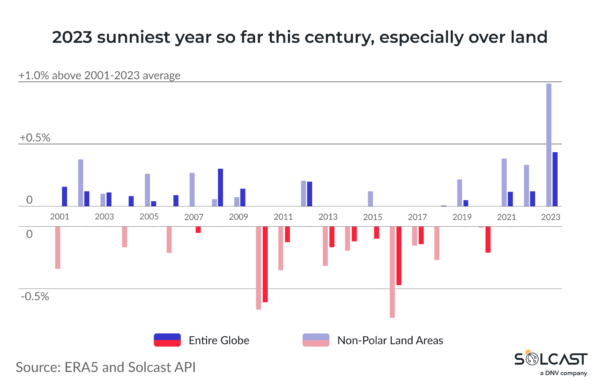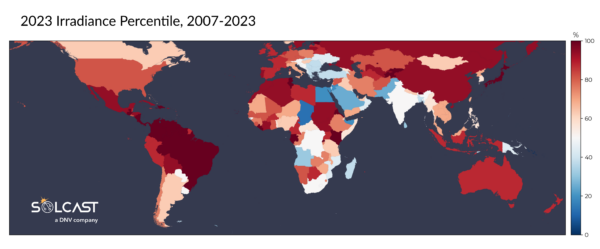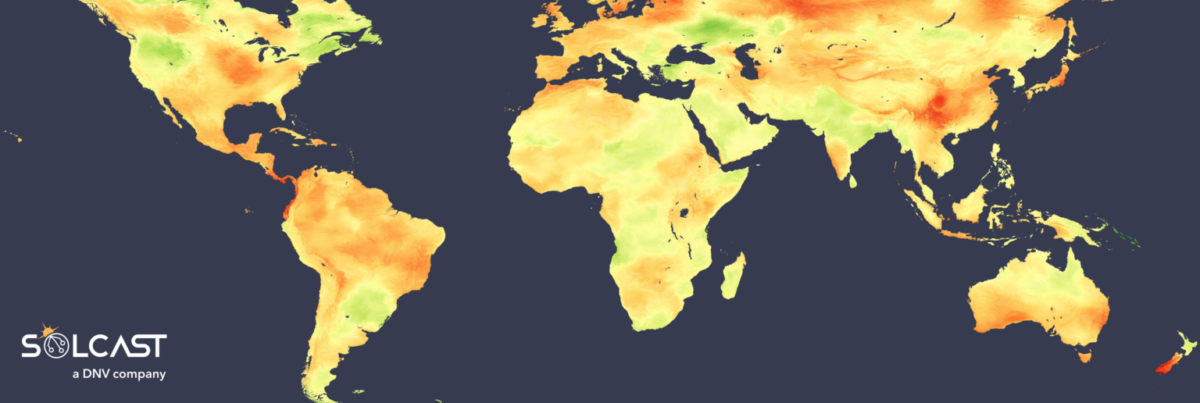From pv magazine global
2023 was not only the hottest year in modern records, but was also the sunniest year so far this century, according to analysis by Solcast.
2023’s margin as the sunniest year of the century was particularly large for non-polar landmasses – the places we live, and the places
where our solar PV systems are located, as El Nino kept moisture and cloud over the Pacific Ocean, and deviations in the Arctic circulation pulled low pressure systems further north into the Arctic Ocean. Large regions were 10% or more above long term trends, including Western and Northern Europe, Eurasia, much of China, Southern Australia, the Midwestern and Southern US, Central and most of South America.
2023: Sunniest year so far this century
Analysis by Solcast reveals that for the entire planet, 2023 saw the highest total solar irradiance of any year this century, using data from Solcast and ECMWF ERA5. 2023 saw total solar irradiance near 0.5% above the long-term average – a small percentage, but equating to an increase of solar energy received of approximately 16,000 TJ.

The anomaly was 1% for combined non-polar land areas, a much larger deviation than any seen in the last 15 years. This deviation was larger than the global total, due to increased cloud formation over the oceans offsetting some of the reduced cloud formation over non-polar land areas.
Americas
The Americas saw above average irradiance, as an early El Nino created a lot of moisture and cloud over the tropical Pacific Ocean, pulling cloud away from the surrounding land areas.
In Central and South America, Brazil and neighboring countries to the north saw the highest irradiance in over 15 years, in a year marked by significant drought in the Amazon. Argentina and Chile further south saw near or slightly above average irradiance. In total, 13 countries in the Americas saw the highest irradiance year in over a decade, including Brazil, Colombia, Venezuela, Guatemala, Dominican Republic, Haiti, Nicaragua and Costa Rica.
North America saw slightly above average irradiance in total, although the North-West and North-East United States both saw cloudier than average conditions. In the North-East conditions will also have been impacted by aerosols, from the Canadian wildfires that burned
for much of the year.
In the U.S. this was offset by large areas of above average irradiance in the Mid-West and South. This was good news for solar production in Texas, which had another record year of solar capacity installations and generation according to the SEIA.
Africa, Europe and the Middle East
Western Europe and Northern Europe saw well above average irradiance, due to Arctic circulations contracting north, reducing the intensity of associated cloud from low pressure systems. Estonia saw the sunniest year they have seen in over 10 years. Whilst these patterns delivered several large and intense storms, cloud cover was lower than average.
Eastern Europe and the Middle East saw below average irradiance as moisture from both the Eastern Mediterranean and Indian Ocean was pushed onshore. Much of Africa saw a relatively normal year for irradiance, with only small deviations relative to average. Despite small deviations, Tunisia, Liberia, Eritrea, Kenya, Gabon, Equatorial Guinea, and Rwanda saw more irradiance in 2023 than they have for any other year in the last decade.

Asia
China saw above average irradiance, with some areas seeing 110% of long term averages, although this was less intense towards the coast. Japan saw the highest national average irradiance in over a decade, especially along the eastern coast near Tokyo, as anomalous westerly winds kept Pacific moisture offshore.
A positive Indian Ocean Dipole contributed to overall below average irradiance across most of India, although the south-western Indian states saw above average irradiance. Across Asia, Kyrgyzstan, Tajikistan, Bhutan, and Japan saw higher irradiance than the last 10 years.
Solcast produces these figures by tracking clouds and aerosols at 1-2km resolution globally, using satellite data and proprietary AI/ML algorithms. This data is used to drive irradiance models, enabling Solcast to calculate irradiance at high resolution, with typical bias of less than 2%, and also cloud-tracking forecasts. This information is used by more than 300 companies managing over 150 GW of solar assets throughout the world.
ERA5 is the fifth generation ECMWF atmospheric reanalysis of the global climate covering the period from January 1940 to present. ERA5 is produced by the Copernicus Climate Change Service (C3S) at ECMWF.
The views and opinions expressed in this article are the author’s own, and do not necessarily reflect those held by pv magazine.
This content is protected by copyright and may not be reused. If you want to cooperate with us and would like to reuse some of our content, please contact: editors@pv-magazine.com.








By submitting this form you agree to pv magazine using your data for the purposes of publishing your comment.
Your personal data will only be disclosed or otherwise transmitted to third parties for the purposes of spam filtering or if this is necessary for technical maintenance of the website. Any other transfer to third parties will not take place unless this is justified on the basis of applicable data protection regulations or if pv magazine is legally obliged to do so.
You may revoke this consent at any time with effect for the future, in which case your personal data will be deleted immediately. Otherwise, your data will be deleted if pv magazine has processed your request or the purpose of data storage is fulfilled.
Further information on data privacy can be found in our Data Protection Policy.